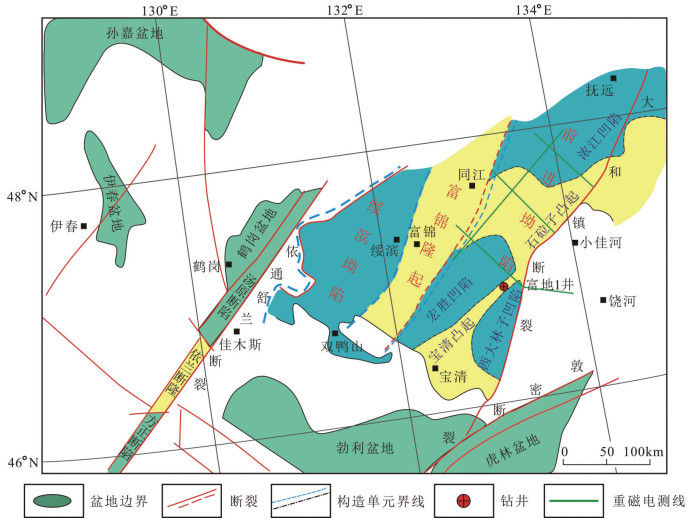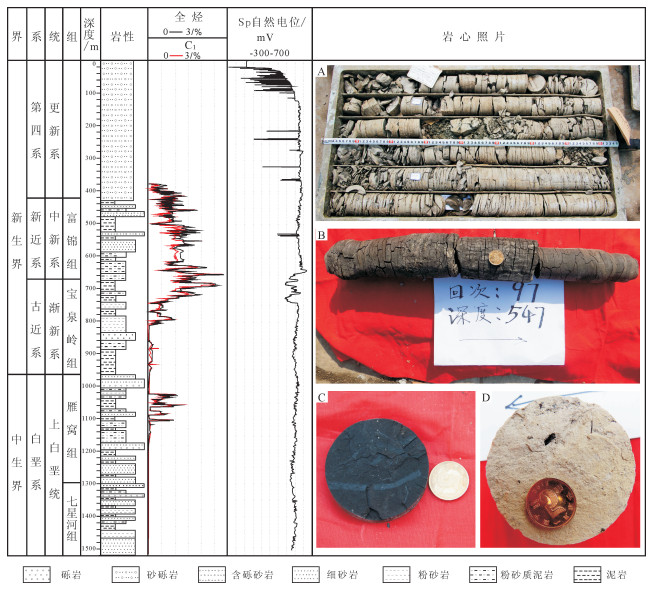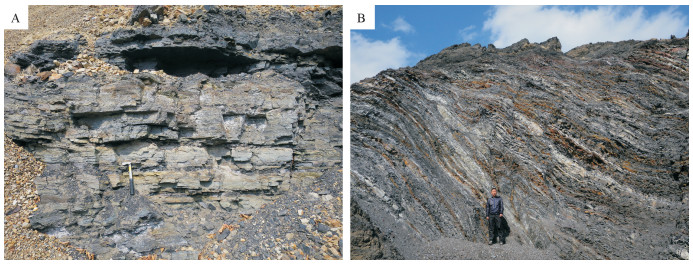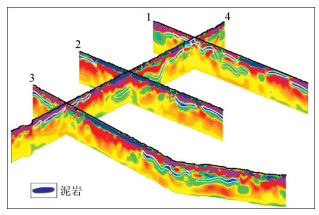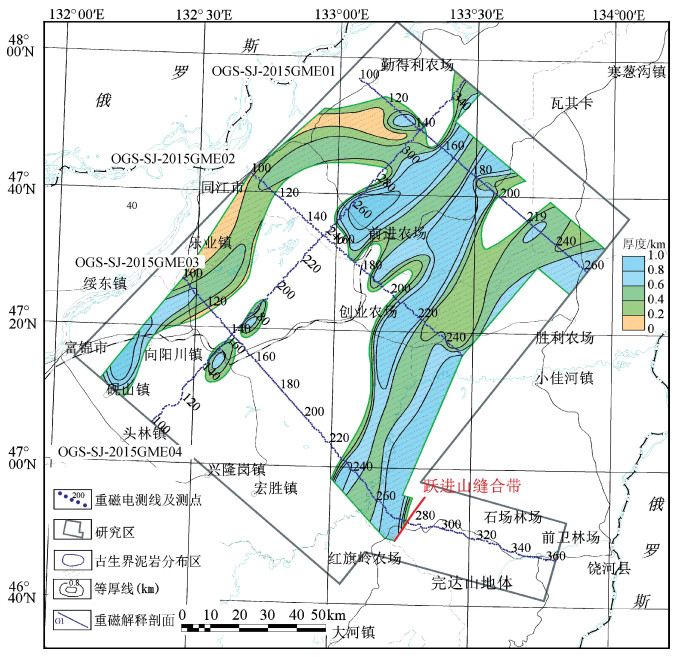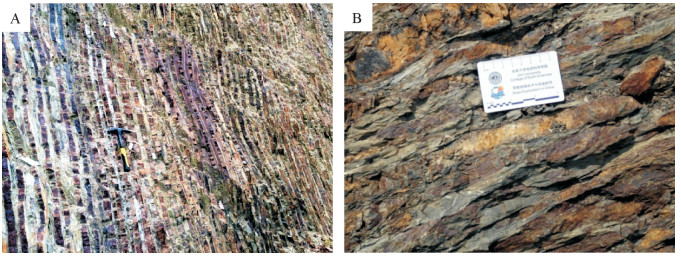Thermodynamic conditions of ore-forming fluid and migration and enrich-ment mechanism of iron in the Tieshan Fe-Cu deposit, southeastern Hubei Province
-
摘要:
对铁山铁铜矿床的流体包裹体研究发现,在石榴子石和透闪石中主要发育气液两相富液相、富气相和含石盐子晶三相包裹体。显微测温结果表明,进矽卡岩阶段热液流体均一温度为499.2~594.8℃,盐度多集中分布在17.3%NaCl~19.5%NaCl之间,密度为0.45~0.62g/cm3,形成压力为58.0~90.6MPa;退化蚀变阶段成矿流体均一温度为356.2~428.6℃,盐度多集中分布在7.2%NaCl~15.5%NaCl之间,密度为0.52~0.83g/cm3,成矿压力为23.8~29.7MPa,成矿深度为0.90~1.12km,主成矿阶段成矿流体具有高温、中-低盐度、低密度、较低成矿压力的特征,属于浅成矽卡岩型铁铜矿床。同时,群体包裹体气液相成分结果显示,气相成分以H2O和CO2为主,并含有少量CH4、C2H6、N2和H2S气体;液相成分阳离子以Na+、Ca2+、K+为主,阴离子以SO42-、Cl-为主。研究表明,Cl-、SO42-和碳酸络合物在铁质搬运与富集过程中发挥了重要作用,流体混合和成矿热液pH值的系统演变可能是导致铁山铁铜矿床铁质超常富集沉淀的重要机制。
Abstract:Based on petrographic observations of garnet and tremolite collected from the Tieshan Fe-Cu deposit, the authors found that the primary fluid inclusions are generally of three types:gaseous inclusions, liquid inclusions and halite daughter mineral-bearing three-phase inclusion. According to temperature measurement results, the homogenization temperatures at the prograde skarn stage range from 499.2℃ to 594.8℃, the fluid salinity peak values range from 17.3%NaCl to 19.5%NaCl, the densities range from 0.45g/cm3 to 0.62g/cm3, and the pressure ranges from 58.0×106 Pa to 90.6×106 Pa; the homogenization temperatures at the retrograde alteration stage range from 356.2℃ to 428.6℃, the fluid salinity peak values range from 7.2% Nacl to 15.5%NaCl, the densities range from 0.52g/cm 3 to 0.83g/cm3, the metallogenic pressure ranges from 23.8×106 Pa to 29.7×106 Pa, and the metallogenic depth ranges from 0.90km to 1.12km with an average of 0.95km. These data indicate that the ore-forming fluid of the Tieshan Fe-Cu deposit has the characteristics of high temperature, moderate-low salinity, and low density. Therefore, the Tieshan Fe-Cu deposit is an epithermal skarn deposit. Composition analysis of grouped fluid inclusions indicates that gaseous composition is dominated by H2O and CO2, fol-lowed by small amounts of CH4, C2H6, N2 and H2S, the cations of liquid composition are dominated by Na+, Ca2+ and K+, and the an-ions are dominated by SO42- and Cl-. The results show that Cl-, SO42- and carbonate complexes played an important role in migration and enrichment of iron. The mixing of fluids of different origins and the evolution of pH might have been the dominant enrichment and precipitation mechanism of the Tieshan Fe-Cu deposit.
-
三江盆地位于黑龙江省东北部三江平原,西起佳木斯,东至乌苏里江和完达山,北临黑龙江与俄罗斯隔江相望,南至双鸭山分水岭,与俄罗斯的中阿穆尔盆地为同一盆地,中国境内因地处黑龙江、松花江与乌苏里江“三江”汇合处而得名,盆地呈北东方向延伸,面积约33730km2 [1-3](图 1)。
![]() 图 1 三江盆地地理位置[4]Figure 1. Geographic position of Sanjiang Basin
图 1 三江盆地地理位置[4]Figure 1. Geographic position of Sanjiang Basin随着东北大型含油气沉积盆地研究程度越来越高,油气勘探难度越来越大,加之老油田开发程度已进入中后期,亟需新的油气区接替,为油田的增储上产和可持续发展提供接替领域和资源保障。虽然近年来油田系统在松辽盆地开展了一系列的“大庆下面找大庆”的勘探工程,在深层火山岩和致密气勘探领域取得了一些重大突破,但仍难弥补油田开发产能下降的接替需要,勘探和开发成本越来越高。
在油田接替如此紧迫的今天,松辽盆地外围的中小型沉积盆地已成为目前油气勘探的重要领域之一。近年在松辽盆地外围开展了一系列中小型盆地的基础性研究及勘探工作,取得了重要的油气发现突破,例如彰武盆地油气勘探的新突破,突泉盆地突参1井,方正断陷的方4井、方6井,延吉盆地的延4井、延10井等油气新发现,展示了松辽盆地外围这些中小型盆地具有良好的勘探前景。目前,应用基础地质框架、盆地模拟和盆地油气地质条件3种方法,对松辽外围盆地油气远景进行了优选排序,其中三江盆地为7个一级远景盆地之一,具有面积大、埋藏深、发育较好的烃源岩和资源量大等特点。2008年对松辽外围盆地的油气资源进行了重新认识,新计算三江盆地的石油资源量为2.81×108t,表明三江盆地具有较大的油气勘探潜力。
对三江盆地的油气勘探工作始于1959年111地质队在该区开展的地质调查,多年来在该区进行了不懈的油气勘探(表 1),目前虽未取得油气勘探突破,但已在盆地内及其周边发现多处油气显示,表明三江盆地曾经发生过油气的生成、运移,具备油气成藏的物质基础[1, 5-6]。
表 1 三江盆地油气勘探程度Table 1. Statistics of oil and gas exploration degrees in Sanjiang Basin构造带 地震 钻井 航磁/km MT/点 重力/点 磁法/点 化探/个 模拟/km 数字/km 井/口 总进尺/m 绥滨坳陷 4202 5 9102.15 233 7566 富锦隆起 4111 3149 前进坳陷 320.8 1529.3 7 15044.08 14359 89 27110 11418 总计 320.8 5731.3 12 24146.23 14359 322 38787 14567 4316个,面积13760km2 1. 地质背景
三江盆地位于中国东北黑龙江省东部地区,处于依通-舒兰断裂带和敦密断裂带之间(图 2)。现今地质构造属于滨太平洋构造域,多阶段的区域构造演化决定了三江盆地基本构造格局的演化具有特殊性和复杂性。
三江盆地是一个中新生界叠合残留盆地,发育中侏罗统绥滨组、上侏罗统东荣组,下白垩统城子河组、穆棱组、东山组,上白垩统海浪组、七星河组、雁窝组,古近系宝泉岭组和新近系富锦组[2, 5]。三江盆地自西向东构造格局为绥滨坳陷、富锦隆起、前进坳陷(图 2)。盆地内隆起与坳陷相间排列,具东西分带、南北分块特点。隆起与坳陷的两翼不对称,坳陷多为西北翼陡、东南翼缓,而隆起多为西北翼缓、东南翼陡。绥滨坳陷位于盆地西部,面积6440km2,主要由古元古界变质岩系(麻山群)及其内的侵入花岗岩构成,发育上侏罗统和下白垩统。西侧受控于军川断裂,东侧受限于富锦断裂,南为笔架山冲断裂,北为黑龙江断裂。富锦隆起基底为古生代华力西期褶皱岩系,与西部相比,发育泥盆纪和石炭纪—二叠纪浅变质岩系,并伴有华力西期花岗岩的侵入。前进坳陷位于富锦隆起以东,大和镇断裂以西,面积22000km2,总体形态为北北东向转为北东东向的近“S”型的带状坳陷,以新生代沉积为主,发育中生代地层。
总体而言,盆地基底由西向东地层由老变新,古生代以来的地层分布方向与佳木斯隆起、那丹哈达岭褶皱带的构造轴线基本一致,为北东向或北北东向。在沉积建造上,不同时代地层自西向东由陆相变为海相,说明盆地基底是自元古宙早期开始逐步形成,由于陆地不断向东扩张,海水后退,构成了不同时代的拼合基底。
2. 石油地质调查进展
2.1 中新生界泥页岩调查进展
三江盆地前进坳陷地层自下而上为下白垩统东山组,上白垩统海浪组、七星河组和雁窝组,古近系—新近系宝泉岭组、富锦组和第四系[4]。“富地1井”位于三江盆地东部前进坳陷(图 2),完钻深度1518.16m,完钻层位为上白垩统七星河组(图 3),钻孔揭示,该区宝泉岭组、雁窝组与七星河组发育厚层暗色泥岩。雁窝组泥岩厚度115.34m,占该组地层总厚度的34%。七星河组发育炭质泥岩,厚度可达45m。
在“富地1井”钻进过程中,于新近系富锦组(N1f)和古近系宝泉岭组(E3b)中发现连续的气测异常显示,具体特征表现为:总烃含量超过1%,气体为干气,气体组分中C1/(C1~C5)>0.9,重烃含量与非烃含量比重都很小。统计可知,气测异常共计220m/15层,在658m处气测得全烃含量最高异常2.78%(图 3)。观察富锦组和宝泉岭组对应的岩心发现,气测异常段以灰黑色泥岩与炭质泥岩为主(图 3-A~C),有的岩心中可见炭屑颗粒(图 3-D)。经有机地球化学测试,气源岩所对应的岩性主要为暗色泥岩、炭质泥岩及煤层(表 2)。其中暗色泥岩TOC含量介于0.36%~2.64%之间,有机质类型好(以Ⅱ1—Ⅱ2型为主),Ro值介于0.32%~0.33%之间,反映烃源岩处于未成熟阶段(表 2)。
表 2 富地1井岩心地球化学指标Table 2. Geochemical indicators of Fudi 1 well core样品编号 地层 岩性 TOC/% S1+S2(mg·g-1) Tmax/℃ Ro/% 有机质丰度 干酪根类型 FD1-449 富锦组 泥岩 0.47 0.43 428 0.32 差 Ⅱ1 FD1-457 富锦组 泥岩 2.64 3.03 437 0.34 好 Ⅱ1 FD1-547 富锦组 煤 49.21 146.80 371 0.33 好 Ⅱ2 FD1-915 宝泉岭组 炭质泥岩 31.59 144.88 419 0.33 好 Ⅱ1 FD1-1187 雁窝组 泥岩 1.11 0.84 434 0.35 好 Ⅱ1 FD1-1309 七星河组 泥岩 2.07 4.63 426 0.35 好 Ⅱ2 FD1-1317 七星河组 炭质泥岩 19.02 48.17 416 0.37 好 Ⅱ2 FD1-1326 七星河组 煤 49.73 173.65 418 0.35 好 Ⅱ2 FD1-1345 七星河组 煤 50.59 169.04 417 0.36 好 Ⅱ2 FD1-1368 七星河组 炭质泥岩 34.61 114.52 419 0.37 好 Ⅱ2 FD1-1387 七星河组 炭质泥岩 38.47 115.08 418 0.37 好 Ⅱ2 FD1-1429 七星河组 煤 43.81 207.84 411 0.39 好 Ⅱ2 FD1-1475 七星河组 泥岩 0.36 0.59 449 0.36 非 Ⅱ2 根据气测显示的具体特征可知,其生物气特征明显,而生物气作为微生物作用下生成的天然气,不仅可以大量生成,还可以大规模地聚集成藏[7],生物气藏目前已是一种重要的非常规气藏[8]。研究和勘探成果表明,生物气藏的形成主要受温度、还原-强还原环境、矿化度、水介质pH值、有机质的类型和丰度、快速沉积、迅速埋藏、良好盖层、有利圈闭等众多的化学和地质条件控制[9],这些因素的有利组合可促进丰富的生物气资源的形成。三江盆地具有形成生物气藏的有利条件,如气候寒冷有助于有机质的大量保存,如果地表温度高,各种细菌都很活跃,大量有机质可能在氧化带内就被氧化菌降解,不能形成甲烷;第四系湖相粘土层盖层分布面积广而连续,厚度较大,有利于生物气的保存;新近系富锦组和古近系宝泉岭组黑色、深灰色泥页岩层和煤层可以作为良好的生气层;第四系和古近系、新近系发育良好的储集层,有利于生物气聚集成藏。
2.2 古生界泥页岩调查进展
随着古生界大中型油气田的连续发现,古生界油气资源已成为中国油气勘探的重要接替领域之一[10]。东北地区上古生界一直被认为是海西期褶皱带或碰撞造山带,因此,它被作为中、新生代盆地的变质基底而成为油气勘查的禁区。但近期研究结果表明,东北地区上古生界是复合地块基底之上的第一个具有区域性分布的准盖层沉积,为东北地区油气资源勘探的新层系[11]。通过在三江盆地开展油气勘探及古生界评价研究发现,三江盆地存在古生界、中生界、新生界等多套烃源层系。古生界烃源层主要发育在泥盆系、石炭系—二叠系,中生界烃源层系发育于侏罗系中上统、白垩系下统、白垩系上统,新生界烃源层系主要发育于古近系。
三江盆地上古生界在黑龙江富锦东部砚山镇、盆地南缘宝清等地均有不同程度出露,或为少数浅井所揭露。其中,黑台组(D1-2h)为一套滨-浅海相陆源碎屑岩-碳酸盐岩建造,烃源岩为海相灰岩、生物灰岩和泥岩。珍子山组(C2P1z)主要分布于富锦、密山、宝清地区,岩性为一套正常的陆相碎屑沉积岩夹煤层和少量凝灰质板岩组合,以砂岩、粉砂岩、炭质泥岩和泥岩夹煤层为特征(图 4)。宝清地区珍子山组暗色泥岩累积厚度为56.34m,煤层累积厚度为21.5m,暗色泥岩TOC为2.88%~3.87%,Ro为2.19%~4.15%,有机质类型以Ⅲ型为主,少量Ⅱ2型。密山地区珍子山组暗色泥岩TOC为0.57%~1.83%,Ro为1.12%~1.28%。
为了初步确定三江盆地古生界地层埋深和起伏特征,进一步探索古生界泥岩展布,在三江盆地部署重磁电勘探工程415km(图 2)。通过系统的岩石物性研究,分析各类地质体(地层和不同种类岩体)的物性差异在重磁电异常上的响应,建立重磁电异常与地质体之间的内在联系;使用全平面向上延拓、趋势分析、小波变换等方法进行重磁深源场和浅源场分离,提取反映深部地质体分布、构造格局与展布的异常信息,推测地层与岩体分布;同时利用电法残差法提取泥岩的电性异常;以电性分层为依据,建立地质-地球物理模型,进行正反演拟合计算和综合地质解释,最终确定古生界、岩体及泥岩在剖面沿线的分布与埋深。
以此次4条重磁电剖面为骨架,同时利用以往电法剖面解释成果,结合重磁异常初步判定,本区古生界泥岩主要发育在石炭系—二叠系珍子山组中上部。图 5为本区残差法断面立体透视图,该图中下部低值电性异常可大致反映本区石炭系—二叠系的泥岩分布情况。从平面上看,泥岩主要分布在工区西北侧、东北部及东部地区(图 6)。向西北、东北及向东,古生界泥岩分布范围有进一步扩大趋势。研究区中南部由于多期岩浆侵入作用,古生界泥岩分布较局限。区内古生界泥岩分布面积约4900km2。古生界泥岩厚度一般为200~800m,前进农场北部的古生界泥岩最大厚度约为1100m,本区西南部(砚山镇北部)的古生界泥岩最大厚度约为1000m。所以,根据重磁电勘探成果,珍子山组在三江盆地中、东部分布较广,且暗色泥岩较发育,是本区深部油气勘探的新层系。
2.3 硅质岩研究进展
硅质岩油气藏在世界上的分布非常广泛,但其生烃潜力还需要深入研究。首先,富含硅质介壳的微体古生物(放射虫、硅藻、海绵等)化石的地层往往是含油气盆地内优异的烃源岩层;其次,由于硅质岩致密、坚硬、易碎,因此裂缝发育,其又可作为良好的油气储集层。所以,一些硅质岩分布与油气田存在时空上明显的成生关系[12]。目前国外已发现了源自硅质泥岩的油气田,如俄罗斯的滨里海盆地、伏尔加-乌拉尔盆地和提曼-伯朝拉盆地,都是目前正在开采的世界顶级大油田,但国内对这类油气田尚无报道,需要对其生烃潜力深入探索、研究。
三江盆地抚远及其东部完达山饶河地区广泛发育晚三叠世—早侏罗世硅质岩(图 7)。为了进一步评价三江地区硅质岩的生烃潜力,笔者对三江盆地抚远、饶河、红旗岭3个地区的硅质岩进行了样品采集及相关测试工作。全岩XRD的鉴定结果表明,三江盆地抚远地区大架山组(T3-J1d)发育大套硅质岩(石英含量大于50%),硅质岩脆性矿物含量主要分布在59%~95%之间,平均值为75%,满足作为页岩气储层的条件。饶河与红旗岭地区大架山组(T3-J1d)发育硅质岩(石英含量大于50%),脆性矿物含量介于75.6%~82.5%之间,平均值为79.4%。
有机地球化学指标测试结果显示,硅质岩有机碳含量在0.09%~1.89%之间,平均值为0.45%,其中抚远地区硅质岩有机碳含量较高,平均值达到0.64%,属于中等烃源岩;生烃潜量(S1+S2)在0.01~1.55mg/g之间,平均值为0.16mg/g;硅质岩有机质类型主要为Ⅲ型,少部分为Ⅱ1型。有机质成熟度Ro为2.06%~6.26%,平均值为4.67%;Tmax在451~556℃之间,平均值480℃,伊利石结晶度(CIS)平均值为0.39,硅质岩明显处于高成熟-过成熟阶段(表 3)。大庆油田勘探开发研究院也对完达山地区的放射虫硅质岩进行了有机碳含量测试,测试结果表明有机碳含量在0.5%~0.6%之间。
表 3 饶河、抚远和红旗岭地区硅质烃源岩有机地球化学特征Table 3. Organic geochemical characteristics of siliceous source rock in Raohe, Fuyuan, and Hongqiling areas地区 地层 岩性 TOC/% S1+S2(mg·g-1) 氯仿沥青“A” Tmax/℃ Ro/% 有机质丰度 饶河 T3-J1d 硅质岩 0.09~0.81 0.01~0.07 0.0036~0.0127 450~556 4.74~6.3 差 0.43(14) 0.04(14) 0.0083(4) 484(14) 5.7(3) 抚远 J3d 硅质岩 0.07~1.89 0.04~1.55 0.0051~0.0067 446~492 6.26 中等 0.64(5) 0.38(5) 0.0059(2) 463(5) 红旗岭 T3-J1d 硅质岩 0.06~0.55 0.02~0.09 0.0070(1) 460~525 2.06 非 0.28(5) 0.05(5) 493(5) 整体而言,三江地区硅质岩的有机地球化学指标较低,长期风化可能会导致部分有机地球化学指标降低,就目前而言其仍无法作为该区的有效勘探层系。但鉴于国外已有硅质岩油气田的发现,三江地区海相硅质岩的生烃潜力仍值得进一步探索与研究。
3. 远景区预测
根据重磁电勘探成果,古生界珍子山组在三江盆地中、东部分布较广,尤其是在前进坳陷的北部与东部,暗色泥岩较发育,具较好的烃源岩条件;并且局部构造形态表现为断背斜,有利于油气储集;上覆中新生界泥岩可作为较好的盖层,故上古生界可作为本区深部油气勘探的新层系,三江盆地前进坳陷北部与东部是深部古生界油气勘探的远景区。目前,国际上在硅质岩地层中已经发现并开采的大油气田不乏其例,三江盆地抚远与完达山2个地区广泛发育晚三叠世—早侏罗世硅质岩,开展硅质岩的研究与探索,能够更好地评价生烃潜力。
4. 结论
(1)三江盆地前进坳陷新生界富锦组与宝泉岭组发育厚层暗色泥岩,其有机质含量高,类型好,气测异常丰富,共计220m/15层,生物气特征明显。生物气藏作为一种重要的非常规气藏,具有分布广泛、埋藏浅的特点,越来越受到重视。三江盆地具有形成生物气藏的有利条件,值得进一步勘探与探索。
(2)上古生界作为东北地区油气资源勘探的新层系,在三江盆地东部发育广泛。三江盆地前进坳陷晚古生界珍子山组暗色泥岩累积厚度大,有机质含量高,TOC为2.88%~3.87%,Ro为2.19%~4.15%,有机质类型以Ⅲ型为主。最新的高精度重磁电勘探成果表明,三江盆地前进坳陷古生界珍子山组泥岩分布面积较广,可达4900km2,厚度一般为200~800m。
(3)三江盆地抚远地区与东部完达山地区发育的大套晚三叠世—早侏罗世硅质岩作为特殊的烃源岩,需要对其进行系统、全面的研究与探索,评价其生烃潜力。有机地球化学指标测试显示,硅质岩有机碳含量在0.09%~1.89%之间,平均值为0.45%,生烃潜量(S1+S2)在0.01~1.55mg/g之间,平均值为0.16mg/g;硅质岩有机质类型主要为Ⅲ型,少部分为Ⅱ1型。有机质成熟度Ro为2.06%~6.26%,平均值为4.67%。整体而言,虽然硅质岩的有机地球化学指标较低,但鉴于国外已在此类型地层中发现多处大型油气田,而国内开展的研究非常有限,应加大对其研究及勘探力度,进一步判定其生烃潜力。
致谢: 湖北省地质局第一地质大队魏克涛高级工程师、柯于富工程师在野外岩心观察及样品采集过程中进行了实地指导,在此表示衷心的感谢。 -
图 1 鄂东南地区地质简图(据参考文献[46]修改)
Figure 1. Geological map of southeast Hubei Province
图 2 铁山铁矿床地质略图(据参考文献[13]修改)
Q—第四系; T1d7—大冶群七段白云质大理岩; T1d6—大冶群六段白云质大理岩; T1d5—大冶群第五段大理岩;
T1d4—大冶群第四段含角岩条带大理岩; T1d3—含石榴子石条带大理岩; T1d2—含角岩条带大理岩; T1d1—泥质灰岩;
P2—硅质岩、角岩; δ52-4—含石英闪长岩; δ52-3—正长闪长岩; δ52-2—辉石闪长岩; δ52-1—中细粒含石英闪长岩;
δμ—闪长玢岩; λ—煌斑岩; γπ—花岗斑岩; SK—矽卡岩Figure 2. Geological sketch map of the Tieshan iron deposit
图 8 铁山铁铜矿床流体包裹体NaCl-H2O体系的p-T-ρ-W相图[57]
Figure 8. Phase diagram of p-T-ρ-W for NaCl-H2O system of fluid inclusions from the Tieshan Fe-Cu deposit
图 9 铁山铁铜矿床流体包裹体NaCl-H2O体系的p-T-W-D相图[58]
Figure 9. Phase diagram of p-T-W-D for NaCl-H2O system of fluid inclusion from the Tieshan Fe-Cu deposit
表 1 铁山铁铜矿床流体包裹体显微测温统计结果
Table 1 Microthermometric data of the fluid inclusions from the Tieshan Fe-Cu deposit
主矿物 样品编号 成矿阶段 包裹体类型 包裹体个数 冰点 均一温度/c 盐度/%Nacl 密度/(g·cm-3) 压力/MPa 石榴子石 ZK9-1-1 进矽卡岩阶段 L+V 23 -13.4 ~ -14.9 508.1 ~ 594.8 17.26 ~18.55 0.45 ~ 0.61 59.0 ~ 90.6 L+V+S 5 — 513.8 ~ 532.8 57.54~58.78 0.31 ~ 0.35 — 石榴子石 ZK9-1-2 进矽卡岩阶段 L+V 21 -13.6 ~ -16.1 499.2 ~ 588.1 17.43 ~ 19.53 0.47 ~ 0.62 58.0~87.0 L+V+S 5 — 516.6 ~ 590.2 42.08~60.25 0.20 ~ 0.36 — 透闪石 JS-5-1 退化蚀变阶段 L+V 18 -4.6 ~ -11.5 382.1 ~ 426.3 7.31 ~ 15.47 0.61 ~ 0.74 25.5 ~ 27.5 透闪石 ZK6-1-5 退化蚀变阶段 L+V 19 -6.5 ~ -10.8 386.3 ~ 428.6 9.86 ~ 14.77 0.63 ~ 0.73 26.0 ~ 27.5 L+V+S 2 — 402.4 ~ 404.1 44.59 ~ 45.96 0.57 ~ 0.58 27.4 ~ 27.5 透闪石 ZK6-1-10 退化蚀变阶段 L+V 19 -6.1 ~ -9.6 356.2 ~ 410.2 9.34 ~ 13.51 0.65 ~ 0.76 23.9 ~ 27.1 L+V+S 1 — 395.2 43.34 0.59 0.59 透闪石 ZK12-1 退化蚀变阶段 L+V 18 -5.9 ~ -8.9 362.3 ~ 399.2 9.08 ~ 12.73 0.65 ~ 0.74 24.9 ~ 26.8 注:L-液相,V-气相; S-含石盐子晶;“—”表示未测出 表 2 铁山铁铜矿床流体包裹体气相成分分析结果
Table 2 Compositions of the gas phase in fluid inclusions from the Tieshan Fe-Cu deposit
成分 ZK9-1-2 ZK9-1-4 ZK6-1-5 ZK6-1-10 ZK12-1 JS-5-1 石榴子石 透闪石 H2O 77.48 82.22 91.23 79.32 96.25 99.05 N2 0.949 0.845 0.145 0.249 0.046 0.071 Ar 0.189 0.146 0.037 0.024 0.004 0.022 CO2 20.55 16.11 8.374 20.17 3.639 0.783 CH4 0.689 0.576 0.198 0.214 0.057 0.064 C2H6 0.139 0.095 — — — — H2S 0.004 0.003 — — — 0.007 CO2/H2O 0.265 0.196 0.092 0.254 0.038 0.008 注:“—”为低于检出限,Ar的结果仅供参考 表 3 铁山铁铜矿床流体包裹体液相成分分析结果
Table 3 Compositions of the liquid phase in fluid inclusions from the Tieshan Fe-Cu deposit
成分 ZK9-1-2 ZK9—1—4 ZK6—1—5 ZK6-1-10 ZK12—1 JS-5-1 石榴子石 透闪石 Cl- 6.18 1.05 4.86 5.73 3.18 3.33 SO42- 194 155 39.0 30.8 53.8 73.8 Na+ 52.5 36.3 23.8 9.9 42 19.1 K+ 18.1 17.6 — 1.44 — 21.1 Mg2+ 0.519 0.258 1.04 1.43 0.519 0.39 Ca2+ 22.9 19.1 17.6 19.4 9.6 0.687 注“—”为低于检出限 -
王敏芳, 邓晓东, 毕诗健.丰山斑岩型铜(钼)矿床中铂、钯的富集特征研究[J].地质与勘探, 2009, 45(2):38-43. http://mall.cnki.net/magazine/Article/DZKT200902008.htm Wang M F, Deng X D, Bi S J, et al. Palladium, Platinum and Gold Concentrations in Fengshan Porphyry Cu-Mo Deposit, Hubei Province, China[J]. Acta Geoogica Sinica, 2009, 83(5):893-901. doi: 10.1111/j.1755-6724.2009.00117.x
Wang M F, Gutzmer J, Michalak P P, et al. PGE geochemistry of the Fengshan Porphyry-skarn Cu-Mo deposit, Hubei Province, Eastern China[J]. Ore Geology Reviews, 2014, 56:1-12. doi: 10.1016/j.oregeorev.2013.07.006
周涛发, 范裕, 袁峰, 等.长江中下游成矿带地质与矿产研究进展[J].岩石学报, 2012, 28(10):3051-3066. http://www.cnki.com.cn/Article/CJFDTOTAL-YSXB201404001.htm 赵新福, 李建威, 马昌前.鄂东南铁铜矿集区铜山口铜(钼)矿床40Ar/39Ar年代学及对区域成矿作用的指示[J].地质学报, 2006, 80(6):849-862. http://kns.cnki.net/KCMS/detail/detail.aspx?filename=dzxe200606007&dbname=CJFD&dbcode=CJFQ 杨峰华.湖北大冶铁山矿床钠化蚀变与成矿关系的探讨[J].地质与勘探, 2001, 37(6):20-24. http://www.oalib.com/paper/5215133 谢桂青, 毛景文, 李瑞玲, 等.鄂东南地区Cu-Au-Mo-(W)矿床的成矿时代及其成矿地球动力学背景探讨:辉钼矿Re-Os同位素年龄[J].矿床地质, 2006, 25(1):43-52. http://www.cnki.com.cn/Article/CJFDTOTAL-DQXB200404005.htm 丁丽雪, 黄圭成, 夏金龙, 等.鄂东南地区姜桥花岗闪长岩锆石UPb年龄、Hf同位素特征及其地质意义[J].岩石矿物学杂志, 2013, 32(3):275-290. http://cpfd.cnki.com.cn/Article/CPFDTOTAL-DZDQ201301002047.htm 谢桂青, 李瑞玲, 蒋国豪, 等.鄂东南地区晚中生代侵入岩的地球化学和成因及对岩石圈减薄时限的制约[J].岩石学报, 2008, 24(8):1703-1714. http://www.ysxb.ac.cn/ysxb/ch/reader/view_abstract.aspx?file_no=20080804&journal_id=ysxb 谢桂青, 朱乔乔, 姚磊, 等.鄂东南地区晚中生代铜铁金多金属矿的区域成矿模型探讨[J].矿物岩石地球化学通报, 2013, 32(4):418-426. http://www.wanfangdata.com.cn/details/detail.do?_type=perio&id=kwysdqhxtb201304005 瞿泓滢, 王浩琳, 裴荣富, 等.鄂东南地区与铁山和金山店铁矿有关的花岗质岩体锆石LA-ICP-MS年龄和Hf同位素组成及其地质意义[J].岩石学报, 2012, 28(1):147-165. http://kns.cnki.net/KCMS/detail/detail.aspx?filename=ysxb201201014&dbname=CJFD&dbcode=CJFQ 瞿泓滢, 裴荣富, 姚磊, 等.湖北大冶与矽卡岩型铁矿床有关的铁山岩体中黑云母、角闪石40Ar-39Ar同位素年龄及其地质意义[J].中国地质, 2012, 39(6):1635-1646. http://kns.cnki.net/KCMS/detail/detail.aspx?filename=dizi201206012&dbname=CJFD&dbcode=CJFQ 薛清泼, 徐九华, 陈伟, 等.大冶铁矿尖林山-狮子山矿段接触带形态及控矿规律分析[J].有色金属(矿山部分), 2006, 58(5):14-16. http://www.docin.com/p-476111089.html 石准立, 熊鹏飞, 王定域, 等.湖北铁山"大冶式"铁矿床的某些成因问题[J].地质科技情报, 1983, (S1):10-29. http://www.cnki.com.cn/Article/CJFDTotal-YSKS201304005.htm Li J W, Vasconcelos P M, Zhou M F, et al. Longevity of magmatic-hydrothermal systems in the Daye Cu-Fe-Au District, eastern China with implications for mineral exploration[J]. Ore Geology Reviews, 2014, 57:375-392. doi: 10.1016/j.oregeorev.2013.08.002
何鹏, 严光生, 祝新友, 等.青海赛什塘铜矿床流体包裹体研究[J].中国地质, 2013, 40(2):580-593. http://www.cqvip.com/QK/90050X/201302/45861663.html 黄诚, 李晓峰, 王立发, 等.湖南黄沙坪多金属矿床流体包裹体研究[J].岩石学报, 2013, 29(12):4232-4244. http://www.wanfangdata.com.cn/details/detail.do?_type=perio&id=ysxb98201312012 张承帅, 毛景文, 张长青, 等.福建马坑矽卡岩型铁(钼)矿床流体包裹体特征及成矿机制研究[J].矿床地质, 2013, 32(2):289-307. http://www.cnki.com.cn/Article/CJFDTOTAL-CCDZ2012S1027.htm 倪培, 范宏瑞, 丁俊英.流体包裹体研究进展[J].矿物岩石地球化学通报, 2014, 33(1):1-5. http://www.wanfangdata.com.cn/details/detail.do?_type=perio&id=njdxxb201203001 孙贺, 肖益林.流体包裹体研究:进展、地质应用及展望[J].地球科学进展, 2009, 24(10):1105-1121. doi: 10.3321/j.issn:1001-8166.2009.10.005 武广, 陈毓川, 李宗彦, 等.豫西银家沟硫铁多金属矿床流体包裹体和同位素特征[J].地质学报, 2013, 87(3):353-374. http://www.oalib.com/paper/4892515 杨永飞, 李诺, 王莉娟.河南省东沟超大型钼矿床流体包裹体研究[J].岩石学报, 2011, (5):1453-1466. http://www.wanfangdata.com.cn/details/detail.do?_type=perio&id=ysxb98201105018 范宏瑞, 陶克捷, 谢奕汉, 等.白云鄂博REE-Fe-Nb矿床稀土氟碳酸盐矿物激光拉曼光谱特征及流体包裹体内稀土子矿物的鉴定[J].岩石学报, 2003, 19(1):169-172. http://www.cnki.com.cn/Article/CJFDTotal-XDYQ201004004.htm 黄凡, 刘翠辉, 谢有炜, 等.内蒙古宜里钼矿流体包裹体特征及其地质意义[J].地质与勘探, 2014, 50(3):445-453. http://www.wanfangdata.com.cn/details/detail.do?_type=perio&id=dzykt201403005 杨丹, 徐文艺.激光拉曼光谱测定流体包裹体成分研究进展[J].光谱学与光谱分析, 2014, 34(4):874-878. http://www.cqvip.com/QK/95716X/201504/665716492.html 刘敏, 王志良, 张作衡, 等.新疆东天山土屋斑岩铜矿床流体包裹体地球化学特征[J].岩石学报, 2009, 25(6):1446-1455. https://www.researchgate.net/profile/Jiajun_Liu/publication/279029892_Geochemistry_geochronology_Hf_isotope_and_geological_significance_of_the_Tuwu_porphyry_copper_deposit_in_Eastern_Tianshan_Xinjiang/links/56b3196808aed7ba3fee11dd.pdf?origin=publication_list 杨丹, 徐文艺.多种矿物流体包裹体中液相阴阳离子的同时测定[J].岩石矿物学杂志, 2014, 33(3):591-596. http://industry.wanfangdata.com.cn/yj/Detail/Periodical?id=Periodical_yskwxzz201403017 杨志明, 谢玉玲, 李光明, 等.西藏冈底斯斑岩铜矿带厅宫铜矿床流体包裹体研究[J].矿床地质, 2005, 24(6):584-594. http://kns.cnki.net/KCMS/detail/detail.aspx?filename=kcdz200506001&dbname=CJFD&dbcode=CJFQ 李晓春, 范宏瑞, 胡芳芳, 等.单个流体包裹体LA-ICP-MS成分分析及在矿床学中的应用[J].矿床地质, 2010, 29(6):1017-1028. http://www.wanfangdata.com.cn/details/detail.do?_type=perio&id=kcdz201006006 Ulrich T, Günther D, Heinrich C A. The evolution of a porphyry Cu-Au deposit, based on LA-ICP-MS analysis of fluid inclusions:Bajo de la Alumbrera, Argentina[J]. Economic Geology, 2001, 96(8):1743-1774. doi: 10.2113/gsecongeo.96.8.1743
Rusk B G, Reed M H, Dilles J H, et al. Compositions of magmatic hydrothermal fluids determined by LA-ICP-MS of fluid inclusions from the porphyry copper-molybdenum deposit at Butte, MT[J]. Chemical Geology, 2004, 210(1):173-199. http://cn.bing.com/academic/profile?id=11259219583c0c18c2708478680c8124&encoded=0&v=paper_preview&mkt=zh-cn
陈雷, 秦克章, 李光明, 等.西藏山南努日铜钼钨矿床矽卡岩地球化学特征及成因[J].地质与勘探, 2011, 47(1):78-88. http://kns.cnki.net/KCMS/detail/detail.aspx?filename=dzkt201101010&dbname=CJFD&dbcode=CJFQ 姚鹏, 顾雪祥, 李金高, 等.甲马铜多金属矿床层控矽卡岩流体包裹体特征及其成因意义[J].成都理工大学学报(自然科学版), 2006, 33(3):285-293. http://www.wanfangdata.com.cn/details/detail.do?_type=perio&id=cdlgxyxb200603012 张勇, 孙景贵, 陈冬, 等.延边地区天宝山多金属矿田的流体特征与成矿模式[J].吉林大学学报(地球科学版), 2012, 42(6):1665-1675. http://www.cnki.com.cn/Article/CJFDTotal-ZQYD2015Z1029.htm 赵斌, 赵劲松, 张重泽, 等.大冶-九江地区Fe, Cu(Au)和Au(Cu)矿床夕卡岩矿物里的熔融包裹体特征[J].中国科学(D辑:地球科学), 2002, 32(7):550-561. http://kns.cnki.net/KCMS/detail/detail.aspx?filename=jdxk200207002&dbname=CJFD&dbcode=CJFQ 赵劲松, 夏斌, 丘学林, 等.海南岛石碌矽卡岩铁矿石中石榴子石的熔融包裹体及其意义[J].岩石学报, 2008, 24(1):149-160. https://www.wenkuxiazai.com/doc/238fe5cb360cba1aa911da18-5.html 赵劲松, 赵斌, 李建威, 等.矽卡岩岩浆对中国北方某些矽卡岩型矿床形成的制约——来自包裹体激光拉曼分析证据[J].岩石学报, 2015, 31(4):1079-1088. https://www.wenkuxiazai.com/word/4e483f45e518964bcf847cb7-1.doc Kwak T A P. Fluid inclusions in skarns (carbonate replacement deposits)[J]. Journal of Metamorphic Geology, 1986, 4(4):363-384. doi: 10.1111/jmg.1986.4.issue-4
Meinert L D, Dipple G M, Nicolescu S. World skarn deposits[M]. Economic Geology 100th Anniversary Volume, 2005:299-336.
曹晓峰, 吕新彪, 何谋春, 等.共生黑钨矿与石英中流体包裹体红外显微对比研究——以瑶岗仙石英脉型钨矿床为例[J].矿床地质, 2009, 28(5):611-620. http://www.oalib.com/paper/4573375 王旭东, 倪培, 袁顺达, 等.赣南漂塘钨矿锡石及共生石英中流体包裹体研究[J].地质学报, 2013, 87(6):850-859. https://www.wenkuxiazai.com/doc/05ee86d62cc58bd63186bd9e.html Xu Y, Jiang S, Zhu Z, et al. Mineral chemistry and H-O-S-Pb isotopic compositions of skarn type copper deposits in the Jiurui district of the Middle-Lower Yangtze River metallogenic belt, Eastern China[J]. Ore Geology Reviews, 2015, 69:88-103. doi: 10.1016/j.oregeorev.2015.01.017
张国胜.鄂东南地区构造特征及其控岩控矿规律[J].湖北地矿, 1998, 12(2):16-23. http://www.cnki.com.cn/Article/CJFDTOTAL-DZKQ199904003.htm 王伟, 王敏芳, 郭晓南, 等.鄂东南矿集区铁山铁矿床中磁铁矿元素地球化学特征及其地质意义[J].地质与勘探, 2015, 51(3):451-465. http://www.cqvip.com/QK/93079X/201503/1005690381.html 刘永耀, 孙振华, 杨少铭.鄂东南过渡类型的寒武纪、奥陶纪地层[J].地层学杂志, 1984, 8(2):94-106. http://www.cnki.com.cn/Article/CJFDTotal-GXDX201003006.htm 谢桂青, 赵海杰, 赵财胜, 等.鄂东南铜绿山矿田矽卡岩型铜铁金矿床的辉钼矿Re-Os同位素年龄及其地质意义[J].矿床地质, 2009, 28(3):227-239. http://www.oalib.com/references/17355984 钱晶.铁山铁(铜)矿床地质特征及成矿作用探讨[J].中国矿山工程, 2013, 42(4):4-8. http://www.cnki.com.cn/Article/CJFDTOTAL-XDDZ702.006.htm 朱和平, 王莉娟.四极质谱测定流体包裹体中的气相成分[J].中国科学(D辑:地球科学), 2001, 31(7):586-590. http://www.wanfangdata.com.cn/details/detail.do?_type=perio&id=zgkx-cd200107008 Hall D L, Stemer S M, Bodnar R J. Freezing point depression of NaCl-KCl-H2O solutions[J]. Economic Geology, 1988, 83:197-202. doi: 10.2113/gsecongeo.83.1.197
刘斌, 沈昆.流体包裹体热力学[M].北京:地质出版社, 1999:84-90. 杨丹, 徐文艺, 崔艳合, 等.二维气相色谱法测定流体包裹体中气相成分[J].岩矿测试, 2007, 26(6):451-454. http://www.cqvip.com/qk/95716X/200706/25993960.html 张宝琛, 覃功炯, 王凤阁.辽宁省岫岩县东堡子金矿流体包裹体研究[J].现代地质, 2002, 16(1):26-30. http://www.cnki.com.cn/Article/CJFDTotal-XDDZ200201004.htm 梅微, 吕新彪, 唐然坤, 等.大兴安岭南段西坡拜仁达坝-维拉斯托矿床成矿流体特征及其演化[J].地球科学(中国地质大学学报), 2015, 40(1):145-162. http://mall.cnki.net/magazine/Article/CCDZ201106017.htm 张招崇, 侯通, 李厚民, 等.岩浆-热液系统中铁的富集机制探讨[J].岩石学报, 2014, 30(5):1189-1204. http://www.ysxb.ac.cn/ysxb/ch/reader/view_abstract.aspx?file_no=20140501 杨小男, 徐兆文, 高庚, 等.安徽铜陵朝山金矿床流体包裹体研究[J].岩石学报, 2008, 24(8):1889-1899. http://www.wanfangdata.com.cn/details/detail.do?_type=degree&id=Y1434884 邵洁涟, 梅建明.浙江火山岩区金矿床的矿物包裹体标型特征研究及其成因与找矿意义[J].矿物岩石, 1986, 6(3):103-111. http://www.cnki.com.cn/Article/CJFDTOTAL-DZZK200403010.htm Bischoff J L. Densities of liquids and vapors in boiling NaCl-H2O solutions:A PVTX summary from 300℃ to 500℃[J]. American Journal of Science, 1991, 291:309-338. doi: 10.2475/ajs.291.4.309
Heinrich C. The physical and chemical evolution of low-salinity magmatic fluids at the porphyry to epithermal transition:a thermodynamic study[J]. Mineralium Deposita, 2005, 39(8):864-889. doi: 10.1007/s00126-004-0461-9
Krumbein W C G R. Origin and classification of chemical sediments in terms of pH and oxidation-reduction potentials (A careful study of the pH and oxidation potentials of the common sedimentary environments and the resultantmineralogy)[J]. The Journal of Geology, 1952, 60:1-33. doi: 10.1086/625929
李秉伦, 石岗.矿物中包裹体气体成分的物理化学参数图解[J].地球化学, 1986, 2:126-137. doi: 10.3321/j.issn:0379-1726.1986.02.004 王真光.矿物包裹体成分物理化学参数的计算程序[J].地质与勘探, 1991, 27(7):22-25. http://www.oalib.com/paper/4573431 徐文炘, 陈民扬, 喻铁阶, 等.矿物包裹体成分数据的热力学计算方法及应用[J].矿产与地质, 1985, (1):35-50. http://cpfd.cnki.com.cn/Article/CPFDTOTAL-GDKL200711002091.htm 胡新露, 姚书振, 何谋春, 等.河南省上宫金矿成矿热力学条件及成矿机制[J].中南大学学报(自然科学版), 2013, 44(12):4962-4971. https://www.researchgate.net/profile/Xinlu_Hu/publication/287909150_Metallogenic_thermodynamic_conditions_and_ore-forming_mechanism_of_Shanggong_Gold_Deposit_Henan_Province/links/56f10c5908ae584badc965d2.pdf?origin=publication_detail 吴湘滨, 戴塔根, 何绍勋.湘西南石英脉型金矿矿物流体包裹体pH值和Eh值的估算[J].大地构造与成矿学, 1999, 23(3):248-253. https://www.wenkuxiazai.com/doc/b6cefa92e87101f69f319525.html 刘斌.简单体系水溶液包裹体pH和Eh的计算[J].岩石学报, 2011, 27(5):1533-1542. http://www.wanfangdata.com.cn/details/detail.do?_type=perio&id=ysxb98201105025 苏根利, 李和平, 刘丛强, 等.高温高压下水流体pH值测量[J].地学前缘, 2009, 16(1):27-32. http://www.cqvip.com/QK/98600X/200901/29520780.html Ding K S W E. Direct of pH measurement of NaCl-bearing fluid with an in situ sensor at 400° C and 40 megapascals[J]. Science, 1994, 272:1634-1636. http://cn.bing.com/academic/profile?id=ffdcd90e18efd6d92e1c7295fb53d4b6&encoded=0&v=paper_preview&mkt=zh-cn
唐果. 云南易门凤山铜矿床流体包裹体特征研究[D]. 昆明理工大学硕士毕业论文, 2011. http://cdmd.cnki.com.cn/Article/CDMD-10674-1012262173.htm C F G. Gorrection of Holloway's(1997) adaptatation of the modified Redich-kwong equation of state for calculation of the fugacities of molecular species in supercritical fluids of geological interests[J]. Contributions to Mineralogy and Petrology, 1979, 69:315-318. doi: 10.1007/BF00372333
阴翠珍, 礼彦君.内蒙撰山子金矿流体包裹体特征和成矿物理化学条件探讨[J].太原理工大学学报, 2007, 38(6):477-480. http://www.cqvip.com/qk/90007A/200706/25889817.html 徐文炘.矿物包裹体中水溶气体成分的物理化学参数图解[J].矿产与地质, 1991, (3):200-206. http://cpfd.cnki.com.cn/Article/CPFDTOTAL-ZGKD200510002054.htm 卢焕章, 范宏瑞, 倪培, 等.流体包裹体[M].北京:科学出版社, 2004:181-185. Pirajno F. Hydrothermal processes and mineral systems[M]. Berlin, Germany:Springer, 2009:535-580.
舒全安, 陈培良, 程建荣.鄂东铁铜矿产地质[M].北京:冶金工业出版社, 1992:1-510. Xie G Q, Mao J W, Li R L, et al. Re-Os molybdenite and Ar-Ar phlogopite dating of Cu-Fe-Au-Mo (W) deposits in southeastern Hubei, China[J]. Mineralogy and Petrology, 2007, 90(3/4):249-270. http://cn.bing.com/academic/profile?id=6eff6960e54c59ffaa152be3df7170eb&encoded=0&v=paper_preview&mkt=zh-cn
Xie G, Mao J, Zhao C. Mineralizing pulses and geodynamic setting of Cu-Fe-Au polymetallic deposits in the Lower Yangtze valley, east-central China[M]. Mineral Deposit Research:Meeting the Global Challenge, 2005:1201-1204.
费红彩, 肖荣阁.成矿流体演化与成矿物理化学[J].矿物岩石地球化学通报, 2002, 21(2):139-144. http://www.cnki.com.cn/Article/CJFDTotal-YSKW704.006.htm 涂光炽.中国层控矿床地球化学[M].北京:科学出版社, 1984:1-354. 张朋, 杨宏智, 孙景贵, 等.黑龙江省马连金矿床流体包裹体特征及其地质意义[J].中国地质, 2015, 42(1):265-274. http://www.cqvip.com/QK/90050X/201501/663991050.html 李延河, 谢桂青, 段超, 等.膏盐层在矽卡岩型铁矿成矿中的作用[J].地质学报, 2013, 87(9):1324-1334. http://www.cqvip.com/QK/95080X/201309/47255761.html 张德会.流体的沸腾和混合在热液成矿中的意义[J].地球科学进展, 1997, 12(6):49-55. http://www.cnki.com.cn/Article/CJFDTOTAL-KWYS201002011.htm 王玉荣, 樊文苓, 郁云妹.碱交代与铁矿形成的地球化学机理探讨[J].地球化学, 1981, (1):95-103. http://www.cnki.com.cn/Article/CJFDTotal-CCDZ2015S1224.htm




 下载:
下载:
